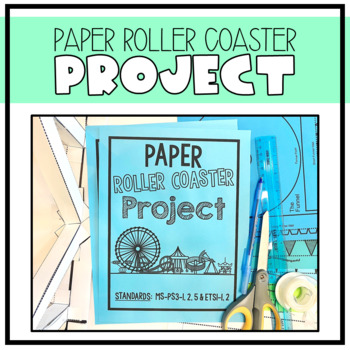Paper Roller Coaster Project- Potential & Kinetic Energy
- Zip
What educators are saying
Description
*The Paper Roller Coaster templates are not included! Those can be found at paperrollercoasters.com.
Description:
Do you need an exciting way to teach your students about potential and kinetic energy? If so, the Paper Roller Coaster Project is the perfect solution! This is by far my students' favorite project throughout the school year! In this project based learning opportunity students are challenged to make the most thrilling and safe paper roller coaster! Students will present their paper roller coaster at a Paper Roller Coaster Carnival on the last day of the project where other students will vote to determine the winner! This is also the perfect opportunity to teach students about potential and kinetic energy and there are checkpoints during the project where students need to show how much they have learned about those concepts.
NOTE: This product gives you a framework for how to implement the project in your class, but it does not provide you with every lesson. We still use our district science curriculum to teach about potential and kinetic energy and infuse those lessons with the challenge of building a paper roller coaster! Some days are devoted for building and other days we do a normal science lesson on potential and kinetic energy.
- All of the resources are editable.
- All of the resources can be used for virtual or in person learning (Google Docs are included).
- This project is aligned to the following Next Generation Science Standards: MS-PS3-1, MS-PS3-2, MS-PS3-5, ETS1-1, & ETS1-2.
What's Included:
- Description of the Paper Roller Coaster Project
- Paper Roller Coaster Project Outline
- Paper Roller Coaster Overview handouts for students
- Link to How to Videos for building paper roller coasters
- Checkpoint #1 Types of Energy Quizizz
- Checkpoint #2 Roller Coaster Plan handout and Google Doc
- Checkpoint #3 Mass, Speed, & Kinetic Quiz (Google Form)
- Checkpoint #4 Potential Energy Model handout and Google Doc
- Checkpoint #5 Potential and Kinetic Energy CER handout and Google Doc
- Checkpoint #6 Evaluating Paper Roller Coasters Matrix handout and Google Doc
- Paper Roller Coaster Carnival details with carnival classroom transformation info and carnival slides (Google slides)
How I Like to Use This Product:
I love to use this project in my 8th grade science class to teach students about potential and kinetic energy and engineering skills! This project takes us about seven weeks to complete. I hope your students enjoy it as much as mine do!
Thank you for visiting my store! I am SO honored you are here! Being able to share ideas with other teachers brings me great joy! If you like this product, please leave a review or share a picture on Instagram of this product in your classroom! Don’t forget to tag @mrsnelsonsmiddles!


